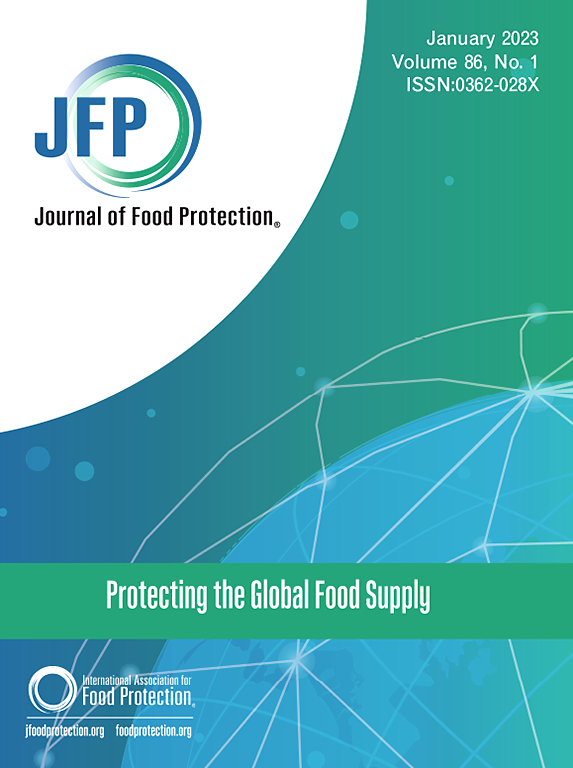Biofilm-forming Abilities of Salmonella Serovars Isolated From Clinically Ill Livestock at 48 and 168 h
IF 2.1
4区 农林科学
Q3 BIOTECHNOLOGY & APPLIED MICROBIOLOGY
引用次数: 0
Abstract
Little is known regarding the biofilm-forming capabilities of a somewhat distinct population of Salmonellae present on-farm and responsible for illnesses in livestock and humans. Evaluation of cleaning and disinfection in preharvest environments has found little success in eradicating Salmonella biofilms to date. Disrupting the environmental survival of Salmonella via biofilm removal will be critical to reducing carriage in livestock reservoirs and the risk of foodborne illness. Therefore, the objective of this study was to characterize the biofilm-forming abilities of Salmonellae relevant to livestock and human health. Eighty-one isolates from 8 serovars (S. Typhimurium, Heidelberg, Montevideo, Agona, Newport, Dublin, 4,[5],12:i:-, Enteritidis) were sourced from poultry and clinically ill cattle, swine, and equine. We hypothesized that biofilm production rate would vary significantly between serovars, and biofilm density would increase from 48 to 168 hrs. Isolates were grown in 24-well microplates in tryptone soy broth at ambient temperature, with media refreshed every 48 h. Biofilm density was quantified using crystal violet assays. Strong biofilm formers comprised 84% (68/81) of isolates tested, while 5.9% (4/81) were considered weak. Biofilm density was significantly greater at 168 h versus 48 h for all serovars except Dublin. Additionally, biofilm growth rate varied by serovar. Differences in biofilm-associated genes were evaluated, and only the detection of csrB was significantly associated with the categorization of biofilm producers. Results suggest inconsistent cleaning likely allows for the establishment of biofilms in on-farm environments. Further, some serovars may pose a greater risk for rapid biofilm establishment. This study provides data necessary to inform the development of evidence-based cleaning and disinfection protocols effective against the most prolific biofilm-forming strains of virulent Salmonella.
临床病畜分离的沙门氏菌血清型在48和168小时的生物膜形成能力。
人们对农场中沙门氏菌的生物膜形成能力知之甚少,而沙门氏菌是造成牲畜和人类疾病的罪魁祸首。对收获前环境的清洁和消毒进行评估后发现,迄今为止在消除沙门氏菌生物膜方面收效甚微。通过清除生物膜来破坏沙门氏菌在环境中的生存,对于减少家畜水库中的沙门氏菌携带量和食源性疾病的风险至关重要。因此,本研究的目的是鉴定与家畜和人类健康相关的沙门氏菌形成生物膜的能力。我们从家禽和临床患病的牛、猪和马身上采集了 8 个血清型(鼠伤寒沙门氏菌、海德堡沙门氏菌、蒙得维的亚沙门氏菌、阿戈纳沙门氏菌、纽波特沙门氏菌、都柏林沙门氏菌、4,[5],12:i:- 沙门氏菌、肠炎沙门氏菌)的 81 个分离物。我们假设不同血清型的生物膜生成率会有显著差异,生物膜密度会在 48 至 168 小时内增加。分离菌株在 24 孔微孔板中的胰蛋白胨大豆肉汤中生长,培养基在环境温度下每 48 小时更换一次。生物膜密度采用水晶紫检测法进行量化。强生物膜形成者占所检测分离物的 84%(68/81),而 5.9%(4/81)被认为是弱生物膜形成者。除都柏林外,所有血清型在 168 小时内的生物膜密度都明显高于 48 小时内的生物膜密度。此外,生物膜的生长速度也因血清种类而异。对生物膜相关基因的差异进行了评估,只有 csrB 的检测与生物膜生产者的分类有明显关联。结果表明,不一致的清洁很可能会在农场环境中建立生物膜。此外,某些血清型可能对快速建立生物膜构成更大的风险。这项研究提供了必要的数据,为制定以证据为基础的清洁和消毒方案提供了信息,这些方案能有效地对付最易形成生物膜的剧毒沙门氏菌菌株。
本文章由计算机程序翻译,如有差异,请以英文原文为准。
求助全文
约1分钟内获得全文
求助全文
来源期刊

Journal of food protection
工程技术-生物工程与应用微生物
CiteScore
4.20
自引率
5.00%
发文量
296
审稿时长
2.5 months
期刊介绍:
The Journal of Food Protection® (JFP) is an international, monthly scientific journal in the English language published by the International Association for Food Protection (IAFP). JFP publishes research and review articles on all aspects of food protection and safety. Major emphases of JFP are placed on studies dealing with:
Tracking, detecting (including traditional, molecular, and real-time), inactivating, and controlling food-related hazards, including microorganisms (including antibiotic resistance), microbial (mycotoxins, seafood toxins) and non-microbial toxins (heavy metals, pesticides, veterinary drug residues, migrants from food packaging, and processing contaminants), allergens and pests (insects, rodents) in human food, pet food and animal feed throughout the food chain;
Microbiological food quality and traditional/novel methods to assay microbiological food quality;
Prevention of food-related hazards and food spoilage through food preservatives and thermal/non-thermal processes, including process validation;
Food fermentations and food-related probiotics;
Safe food handling practices during pre-harvest, harvest, post-harvest, distribution and consumption, including food safety education for retailers, foodservice, and consumers;
Risk assessments for food-related hazards;
Economic impact of food-related hazards, foodborne illness, food loss, food spoilage, and adulterated foods;
Food fraud, food authentication, food defense, and foodborne disease outbreak investigations.
 求助内容:
求助内容: 应助结果提醒方式:
应助结果提醒方式:


